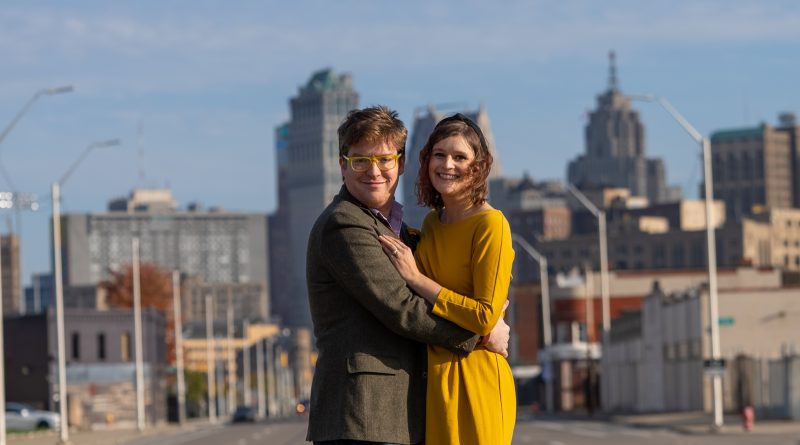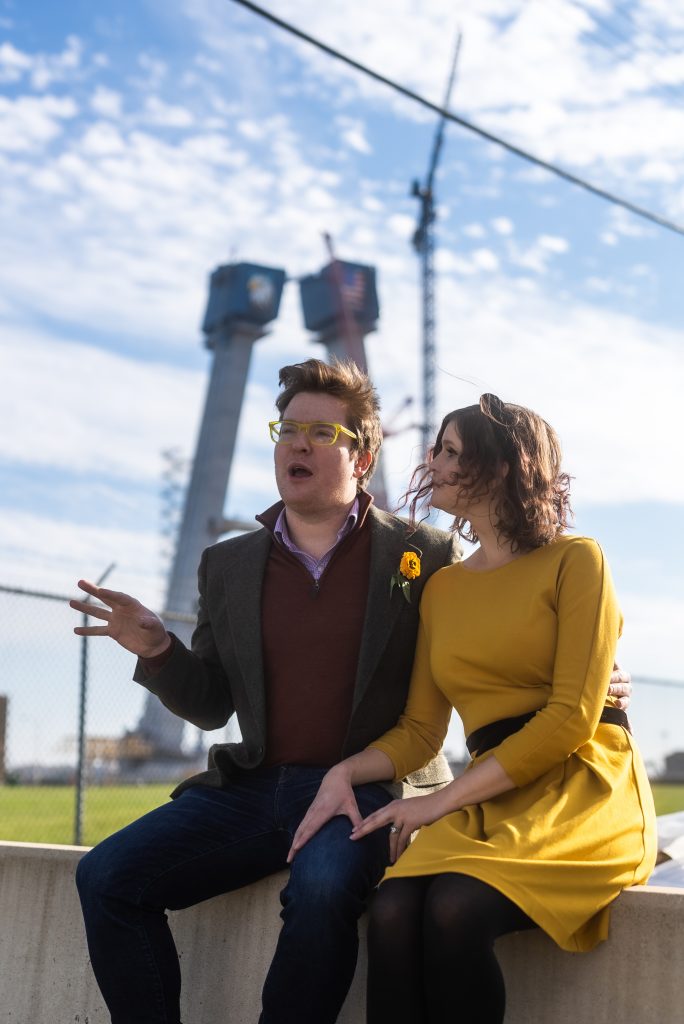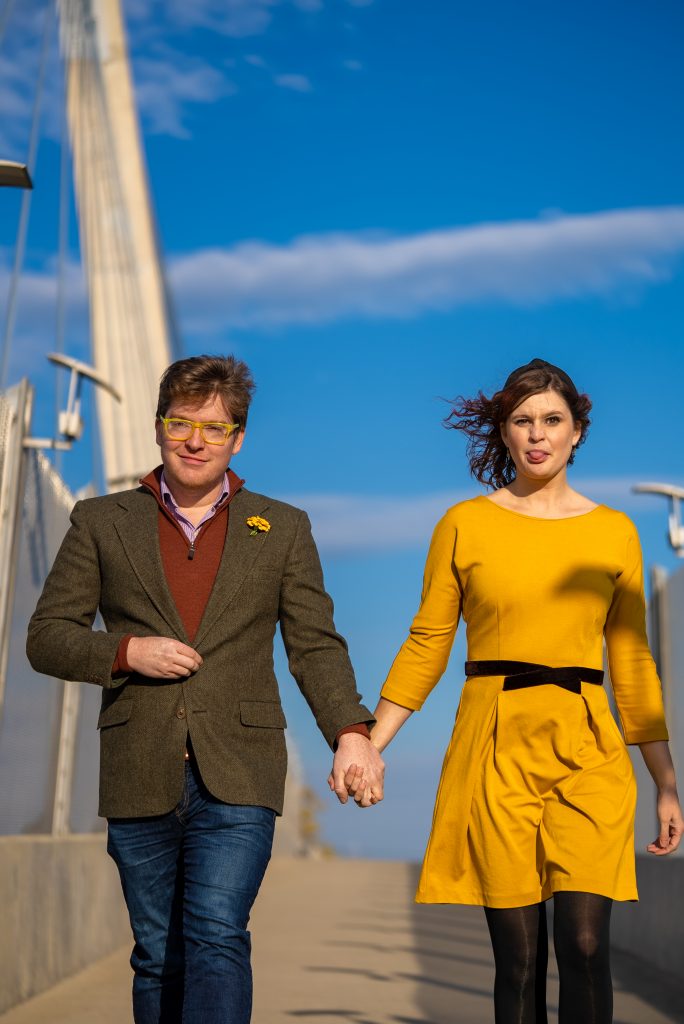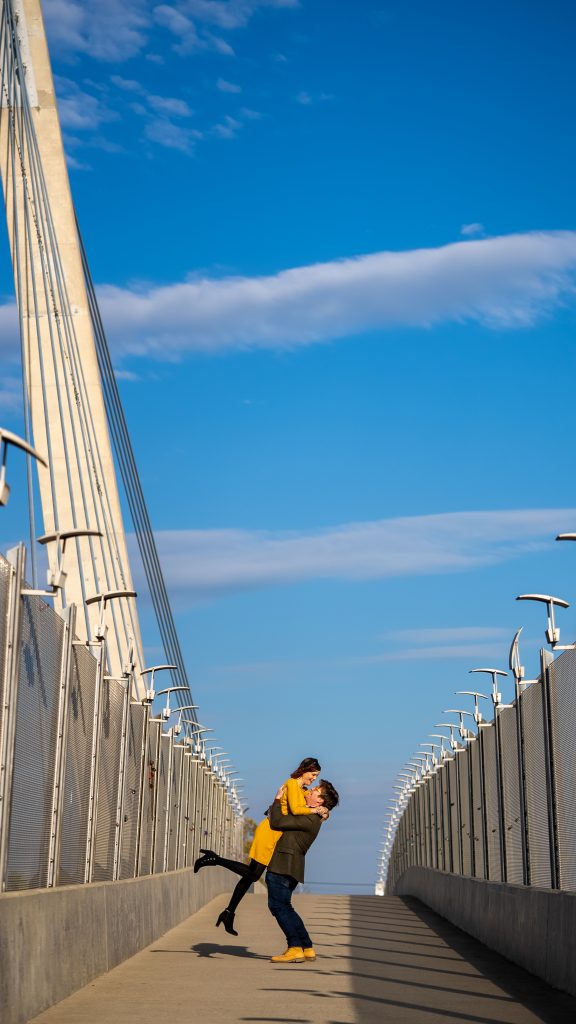A Love Burning Brighter Than The Gas Flares Of Zug Island
As many of you know, or don’t, I got engaged in September! Yes, folks– if someone thinks they can put up with me, there’s hope for literally anyone! It’s rare for me to talk about things other than parking lots or the iniquities of car culture on this website, so I figured some levity by way of engagement photos might be fun. I started thinking about what vibe I might want to go for (we originally hadn’t even really planned on taking any). Further wheels began turning after reading this tweet, in which a fellow Nathaniel also set out to parody the traditional engagement photos by taking his in some particularly insipid suburban streets. It may be a Nathaniel thing. Who knows?
Clearly, we didn’t want to go to the suburbs to take pictures. But I settled on a few locations that I thought might highlight our city’s identity and heritage in a way that might capture the aesthetics of it– but beyond the typical sights that people often gravitate to, like Corktown, or the Fisher Building, or whatever. Plus– it’s always suburbanites coming into Detroit to take these photos. We actually live here. I thought, why not? Detroit is always touting its industrial history. Part of that history involves some impressive aesthetics, while another part involves the city’s spectacular decline. But not ruin porn– it’s the city we live in and love. When we talk about the “grit” of cities like Detroit, I have a visceral aversion to the term being used to mean “perseverance” or “diligence.” We have those, too. Rather, I’m thinking about grit, like the straight up dirt. It’s an industrial thing. We’re an industrial city. That’s what we do. So.
First Stop: Delray and the Gordie Howe International Bridge
First, we set out for Delray, a once-proud neighborhood that has been largely depopulated owing to a century-long process of attrition and, in the past decade, a massive construction project that is building a new international border crossing to the Land of the Rising Timbit. Delray has gotten the shaft in a major way through its proximity to some of the worst environmental offenders, including US Steel and Marathon Oil, which operates a refinery just across the Rouge River. The neighborhood has been gradually depopulated over a gradual century of industrial decline and environmental deterioration, which I’ve written about before and which has been covered extensively in local and even national media.
Settled around the Rouge River in the 19th century around a heavily-industrialized corridor of water power and river trade, the neighborhood once had more than 30,000 residents. It’s down to around a thousand at present. The city’s Bridging Neighborhoods program has pushed to relocate residents in the footprint of the bridge and the inevitable widening of I-75 (why are we doing this in 2021?) with a generous buyout package. It also administers some community benefits associated with the bridge project, focusing on the environmental justice issue– given the exceptionally poor air quality in this neighborhood.

Industrial Air, Postindustrial Future
Once, in a former life, I submitted a proposal to Findlay, Ohio-based Marathon Petroleum– not to be confused with its related, but quite separate entity, Marathon Oil- for a community grant program that would help provide extensive air sealing and air filtration to homes in the Boynton/Oakwood Heights neighborhoods. It was kind of a “let’s do a last ditch attempt at climate-but-also-industrial-pollution-adaptation” thing. More specifically, I was trying to save a once-and-former home of civil rights champion Rosa Parks, whose descendants had inherited the home and were eager to try and preserve it. Unsurprisingly, Marathon never responded. They routinely deny that their facility causes any problems.
Like, you know, the stale fart smell of refinery. Or explosions— oh wait, they actually settled that case. I mention this as a good illustration of how the neighborhood’s power dynamics work. US Steel is another Big Bad Offender. They’ve never responded to a single media inquiry I’ve submitted to them.
Anyway, onward.
To avoid self-incrimination, I can’t tell you whether the above photos are actually real, or whether we just photoshopped them on front of a backdrop of the bridge, because at some point, a uniformed teenager came up in a truck to tell us how the city street was actually government property, and we were illegally trespassing on federal property, because the bridge was a federal project, and we aren’t allowed to take pictures of a thing that is visible from a public right-of-way. It’s my experience that arguing with cops or people who are acting like a cop is generally unproductive, even if you’re in the right and they’re just being, well, dicks. So, suffice it to say, I told him to have a good one, and we drove off.
As an aside, the GHIB project seems to employ a lot of private security, which includes a lot of ex-Detroit cops or off-duty Detroit cops, a category of humans that I trust slightly less than I trust Mark Zuckerberg or, say, Lyle Lanley. I did actually speak to a representative of the bridge company– a Canadian, of course- who told me that, while there are indeed restricted areas, they fall under state jursidiction, actually, not federal jurisdiction– and the public right-of-way would indeed be included under a public street.
As an aside to that aside, this is one of the most excruciatingly obnoxious– but intellectually somewhat intriguing- things about city planning that I imagine similarly dogs the likes of law enforcement professionals as it does city building departments– the butting of heads over jurisdictions. It’s like in the TV shows, where the city detective is like, “butt out of my investigation, G-man!” and some slick, black-besuited FBI agent thanks him for his service and gives him a snide brushoff. The same thing happens all the time in the city planning space, especially at the municipal level of enforcement. I remember having some words with a postal facility manager back in the day over his refusal to comply with various city ordinances that were turning his property into a minor nuisance in the neighborhood.
But I digress.
Second Stop: The Pearlescent Waters of the Rouge River
At left, me and my hunny emerge from the brush along the petrochemical-pearlescent waters of the Rouge River. At right, one of our many candids. The Rouge River’s historical wetlands are mostly gone in this area, but we do encounter some native species here. We note an interesting intermingling of natural ecologies, industrial ecologies, and urban typologies, between the brush-covered areas of the riverbanks, the mixture of mostly abandoned residential and commercial buildings along Jefferson Avenue, and the industrial and infrastructure facilities that line the river– and face the Detroit side of the river from Zug Island itself. (Zug Island technically resides in the city limits of River Rouge, Michigan).
Left, we are standing in front of a railroad swing bridge that connects Zug Island to Detroit proper. Here we’re also close to a former Honeywell site, where an ongoing cleanup effort is underway to remove thousands of cubic yards of contaminated sediment from an old tar plant. The smokestacks of the Great Lakes Water Authority‘s treatment plant, which belches a lustrous, sulfur-yellow smoke into the air on many days, is visible in the distant background. And yet there’s still nature here. You can even kayak the area.
Right is the two of us– again a bit of a candid, but extremely on-brand for the both of us- walking down what I call the Obama Bridge, a.k.a. ARRA-era (but, if I recall correctly, actually built as the law was being signed, from a 2008 package– we are not giving Bush II credit) pedestrian bridge that follows the path of Bagley Street across I-75 in Southwest Detroit, a major pedestrian and bike route that avoids the glass-shard-littered deathtrap of Vernor Highway.
Of course, we have to have the obligatory kick-up-the-heels shot– in which I think the human angles nicely complement the soaring modernist structure of the pedestrian bridge. This bridge, framed on the west side by family-owned Mexican bakeries and restaurants and on the east by modern office and multi-use community space, serves as an elegant anchor to a neighborhood that is both ethnically and architecturally quite diverse. This is also the sort of gateway to Southwest Detroit, marking the end of the spillover of Corktown’s New Detroit– of glitzy unaffordability- and the vibrant, gritty streetscapes of Southwest, in some of the city’s oldest neighborhoods.
At right, we have a shot taken– quite close to Motor City Casino (Ilitches)- in the middle of Grand River Avenue. The Book Tower (Gilbert), Penobscot Building (Not-Gilbert), One Detroit Center (Ally Financial, a.k.a. the Phoenix that rose from the ashes of GMAC– not to be confused with the new GM Financial), and others are visible in the distant background.
I’m sorry for my stupid grin in the picture on the right. Don’t mind me. I’m probably just thinking about infrastructure.
Detroit-based videographer, photographer, and digital artist Noah Balanda took these pics, by the way. He’s a champion and a half if you’re looking for a photographer!











